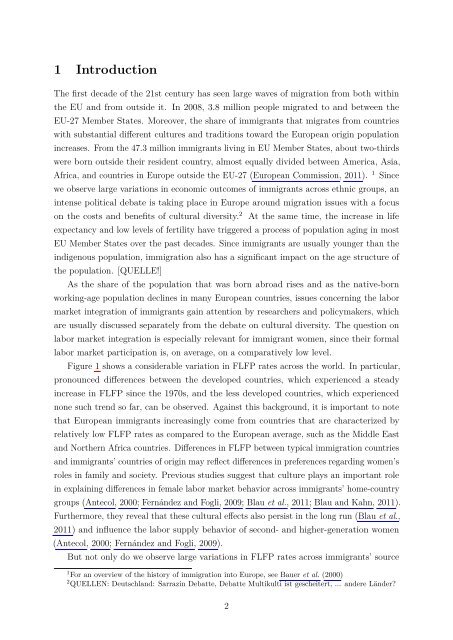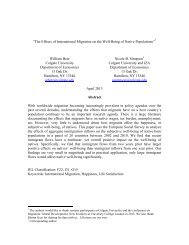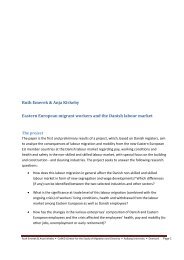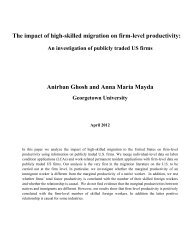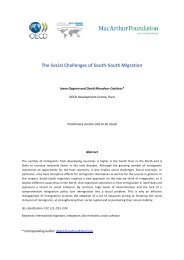The Role of Source- and Host-Country Characteristics in ... - CReAM
The Role of Source- and Host-Country Characteristics in ... - CReAM
The Role of Source- and Host-Country Characteristics in ... - CReAM
You also want an ePaper? Increase the reach of your titles
YUMPU automatically turns print PDFs into web optimized ePapers that Google loves.
1 Introduction<br />
<strong>The</strong> first decade <strong>of</strong> the 21st century has seen large waves <strong>of</strong> migration from both with<strong>in</strong><br />
the EU <strong>and</strong> from outside it. In 2008, 3.8 million people migrated to <strong>and</strong> between the<br />
EU-27 Member States. Moreover, the share <strong>of</strong> immigrants that migrates from countries<br />
with substantial different cultures <strong>and</strong> traditions toward the European orig<strong>in</strong> population<br />
<strong>in</strong>creases. From the 47.3 million immigrants liv<strong>in</strong>g <strong>in</strong> EU Member States, about two-thirds<br />
were born outside their resident country, almost equally divided between America, Asia,<br />
Africa, <strong>and</strong> countries <strong>in</strong> Europe outside the EU-27 (European Commission, 2011). 1 S<strong>in</strong>ce<br />
we observe large variations <strong>in</strong> economic outcomes <strong>of</strong> immigrants across ethnic groups, an<br />
<strong>in</strong>tense political debate is tak<strong>in</strong>g place <strong>in</strong> Europe around migration issues with a focus<br />
on the costs <strong>and</strong> benefits <strong>of</strong> cultural diversity. 2<br />
At the same time, the <strong>in</strong>crease <strong>in</strong> life<br />
expectancy <strong>and</strong> low levels <strong>of</strong> fertility have triggered a process <strong>of</strong> population ag<strong>in</strong>g <strong>in</strong> most<br />
EU Member States over the past decades. S<strong>in</strong>ce immigrants are usually younger than the<br />
<strong>in</strong>digenous population, immigration also has a significant impact on the age structure <strong>of</strong><br />
the population. [QUELLE!]<br />
As the share <strong>of</strong> the population that was born abroad rises <strong>and</strong> as the native-born<br />
work<strong>in</strong>g-age population decl<strong>in</strong>es <strong>in</strong> many European countries, issues concern<strong>in</strong>g the labor<br />
market <strong>in</strong>tegration <strong>of</strong> immigrants ga<strong>in</strong> attention by researchers <strong>and</strong> policymakers, which<br />
are usually discussed separately from the debate on cultural diversity. <strong>The</strong> question on<br />
labor market <strong>in</strong>tegration is especially relevant for immigrant women, s<strong>in</strong>ce their formal<br />
labor market participation is, on average, on a comparatively low level.<br />
Figure 1 shows a considerable variation <strong>in</strong> FLFP rates across the world. In particular,<br />
pronounced differences between the developed countries, which experienced a steady<br />
<strong>in</strong>crease <strong>in</strong> FLFP s<strong>in</strong>ce the 1970s, <strong>and</strong> the less developed countries, which experienced<br />
none such trend so far, can be observed. Aga<strong>in</strong>st this background, it is important to note<br />
that European immigrants <strong>in</strong>creas<strong>in</strong>gly come from countries that are characterized by<br />
relatively low FLFP rates as compared to the European average, such as the Middle East<br />
<strong>and</strong> Northern Africa countries. Differences <strong>in</strong> FLFP between typical immigration countries<br />
<strong>and</strong> immigrants’ countries <strong>of</strong> orig<strong>in</strong> may reflect differences <strong>in</strong> preferences regard<strong>in</strong>g women’s<br />
roles <strong>in</strong> family <strong>and</strong> society. Previous studies suggest that culture plays an important role<br />
<strong>in</strong> expla<strong>in</strong><strong>in</strong>g differences <strong>in</strong> female labor market behavior across immigrants’ home-country<br />
groups (Antecol, 2000; Fernández <strong>and</strong> Fogli, 2009; Blau et al., 2011; Blau <strong>and</strong> Kahn, 2011).<br />
Furthermore, they reveal that these cultural effects also persist <strong>in</strong> the long run (Blau et al.,<br />
2011) <strong>and</strong> <strong>in</strong>fluence the labor supply behavior <strong>of</strong> second- <strong>and</strong> higher-generation women<br />
(Antecol, 2000; Fernández <strong>and</strong> Fogli, 2009).<br />
But not only do we observe large variations <strong>in</strong> FLFP rates across immigrants’ source<br />
1 For an overview <strong>of</strong> the history <strong>of</strong> immigration <strong>in</strong>to Europe, see Bauer et al. (2000)<br />
2 QUELLEN: Deutschl<strong>and</strong>: Sarraz<strong>in</strong> Debatte, Debatte Multikulti ist gescheitert, ... <strong>and</strong>ere Länder?<br />
2


